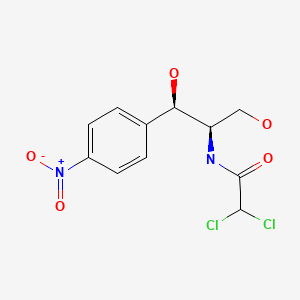CASRN: 56-75-7

Drug Levels and Effects
Summary of Use during Lactation
Adverse reactions such as vomiting, excessive intestinal gas and falling asleep at the breast have been reported in breastfed infants whose mothers were taking oral chloramphenicol. Milk concentrations are not sufficient to induce "gray baby" syndrome, but since chloramphenicol-induced aplastic anemia is not dose-related, this might occur, but has not been reported. An alternate drug is preferred to chloramphenicol during breastfeeding, especially while nursing a newborn or preterm infant. If the mother must receive chloramphenicol during nursing, monitor the infant for gastrointestinal disturbances and adequacy of nursing. Monitoring of the infant's complete blood count and differential is advisable. In some cases, discontinuation of breastfeeding might be preferred.
Drug Levels
Maternal Levels. Milk concentrations reported vary somewhat apparently due to the use of older assay techniques in early studies.[1-3]
Peak milk levels in 10 breastfeeding women were 1.7 to 2.8 mg/L during therapy with 250 mg orally 4 times daily and 3.6 to 6.1 mg/L during therapy with 500 mg orally 4 times daily.[1]
Four women were given a single dose of chloramphenicol 500 mg orally. The average peak milk concentration of 3.24 mg/L (range 2.5 to 4.5 mg/L) occurred 2 hours after the dose. By 8 hours after the dose, the milk concentration averaged 0.31 mg/L. In 5 other women given chloramphenicol 500 mg 3 times daily by mouth at 7-hour intervals for 2 days, breastmilk chloramphenicol levels were 1.72 and 0.66 mg/L at 24 and 48 hours after the first dose. The average half-life in milk was 1.77 hours.[2]
After a single oral dose of 500 mg of chloramphenicol in 2 women, the drug was first measurable in milk in a concentration of 3.3 mg/L 2 hours after the dose. At 4 and 6 hours after the dose, milk concentrations averaged 4.1 mg/L at both times.[3]
Infant Levels. Relevant published information was not found as of the revision date.
Effects in Breastfed Infants
One study reported 50 breastfed infants whose mothers were give oral chloramphenicol beginning 2 to 12 days postpartum in dosages of 1 (n = 20), 2 (n = 20)or 3 grams (n = 10) daily. All of the infants refused to suck, and 50 to 60% fell asleep during nursing. Vomiting occurred after feeding in 10%, 25%, and 90% of infants with daily maternal dosages of 1, 2 and 3 grams, respectively. All infants had excessive intestinal gas and abdominal distention, with severe problems in 0.5%, 20% and 100% of infants with daily maternal dosages of 1, 2 and 3 grams, respectively.[4]
Effects on Lactation and Breastmilk
Relevant published information was not found as of the revision date.
References
- 1.
- Havelka J, Hejzlar M, Popov V, et al. Excretion of chloramphenicol in human milk. Chemotherapia (Basel). 1968;13:204–11. [PubMed: 5750653]
- 2.
- Plomp TA, Thiery M, Maes RA. The passage of thiamphenicol and chloramphenicol into human milk after single and repeated oral administration. Vet Hum Toxicol. 1983;25:167–72. [PubMed: 6868331]
- 3.
- Matsuda S. Transfer of antibiotics into maternal milk. Biol Res Pregnancy Perinatol. 1984;5:57–60. [PubMed: 6743732]
- 4.
- Havelka J, Frankova A. Cesk Pediatr. 1972;27:31–3. [Adverse effects of chloramphenicol in newborn infants] [PubMed: 5010584]
Substance Identification
Substance Name
Chloramphenicol
CAS Registry Number
56-75-7
Drug Class
Breast Feeding
Lactation
Anti-Infective Agents
Antibacterial Agents
Disclaimer: Information presented in this database is not meant as a substitute for professional judgment. You should consult your healthcare provider for breastfeeding advice related to your particular situation. The U.S. government does not warrant or assume any liability or responsibility for the accuracy or completeness of the information on this Site.
Publication Details
Publication History
Last Revision: March 17, 2021.
Copyright
Attribution Statement: LactMed is a registered trademark of the U.S. Department of Health and Human Services.
Publisher
National Institute of Child Health and Human Development, Bethesda (MD)
NLM Citation
Drugs and Lactation Database (LactMed®) [Internet]. Bethesda (MD): National Institute of Child Health and Human Development; 2006-. Chloramphenicol. [Updated 2021 Mar 17].